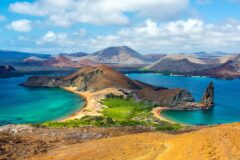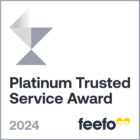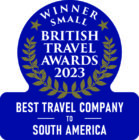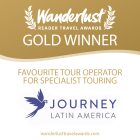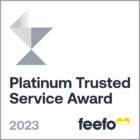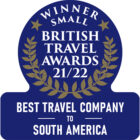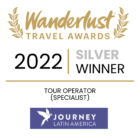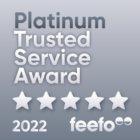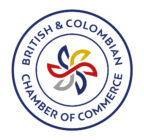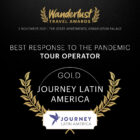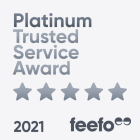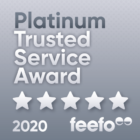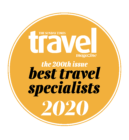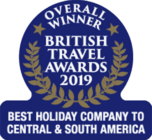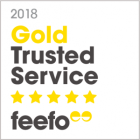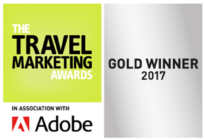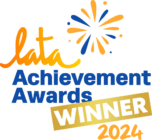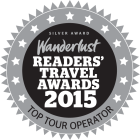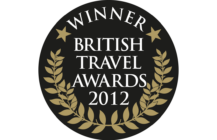Overview & Highlights
This gastronomic holiday allows you to savour and get acquainted with Peruvian cuisine, as well as sample some of the local beverages such as pisco, the celebrated brandy liquor, and local wines. Who knows, you may try some of these recipes at home.
- Guided tour of Miraflores and markets
- Cookery lesson, Lima
- Visit to catacombs, San José
- Tour of vineyard, Ica
- Visit to wine vaults, Ica
- Circo Cabaret, Sacred Valley (selected days only)
- Guided visit to Pisac market and ruins, Sacred Valley
- Guided tour of Machu Picchu
- Guided tour of the city of Cusco and nearby ruins
- Tour of chocolate museum and cookery lesson
Peruvian cuisine isn’t all about potatoes. You might also have heard that guinea pig is a local delicacy. But there is so much more; and delicious recipes are starting to receive world-wide recognition. Some of the world’s best restaurants are in Lima. On this holiday you will visit Peru’s highlights including Cusco and Machu Picchu, with visits to markets, vineyards and a couple of cookery lessons built in.
Fusion cookery is à la mode and Peruvian dishes exemplify this so well: a country of immigrants,Peru has evolved a menu of scrumptious meals in which Chinese, Japanese, African, Italian, German, Spanish flavours and textures blend with age-old delicacies conceived by the indigenous populations of the Andes, the desert coast and the Amazon: the choice of ingredients is as wide as the variety of landscapes from which they come.
Outline itinerary
Day 1
Arrive in Lima and transfer to hotel in Miraflores.
Day 2
Introduction to Lima’s markets, cookery lesson.
Day 3
Drive to Ica, tour of vineyard, wine tasting; overnight.
Day 4
Visit small private distillery, pisco tasting at Bodega La Caravedo.
Day 5
Bus to Lima, fly to Cusco, transfer to Urubamba in the Sacred Valley of the Incas.
Day 6
At leisure. Optional lunch at Wayra Ranch, with pace horse presentation, taster menu dinner with wine.
Day 7
Full day guided excursion to Pisac market and ruins with lunch.
Day 8
Transfer to Ollantaytambo, train to Machu Picchu, guided tour of the ruins, overnight.
Day 9
Return to Cusco for 3 nights.
Day 10
Walking tour of the city and market.
Day 11
Visit to Choco (chocolate) Museum and chocolate-making lesson.
Day 12
Fly to Lima to connect with international flight.
Itinerary
Day 1
Arrive in Lima and transfer to hotel in Miraflores.
Arrive in Lima and transfer to your hotel in Miraflores. This Pacific-side quarter contains a number of top restaurants, best known among which is the internationally lauded German-Peruvian Astrid&Gastón, with traditional Peruvian and fusion taster menus.
More nostalgic is Rosa Nautica, set on a pier over the crashing waves of the Pacific, serving excellent sea bass. Another classy eaterie with a spectacular location opposite the pre-Columbian adobe pyramid of the same name – illuminated at night – is Huaca Pucllana, which serves a good range of Peruvian dishes including the renowned seafood ceviche.

Day 2
Introduction to Lima’s markets, cookery lesson.
This exciting gastronomic experience takes you deep into the heart of Peruvian cuisine. With your guide, walk through the centre of Miraflores. At Surquillo market, you can inspect the various stalls piled high with succulent products. Some are native, others are imported but have thrived here: potatoes (there are hundreds of varieties), chilli peppers, beans, avocados, corn, quinoa, yucca, plantains, mangos.
Having strolled through Miraflores Central Park you’ll stop off for a snack at La Lucha Sanguchería, a famous sandwich shop and popular haunt for local residents. You will also savour chicha morada, a traditional beverage made from purple corn, and wander through the cliff-side Parque del Amor, famous for its romantic sculpture of two lovers embracing, from which there are superb views of the Pacific Ocean. Following a short drive to San Isidro Market, where you may spot one or two of the city’s most innovative chefs searching for their next recipe inspiration, you’ll visit Abel and Eduardo – the influential father and son fish vendors whose stall has been a mainstay for many years.
The highlight of the tour is the opportunity to try out some of Peru’s most well known recipes yourself. In the kitchen of Hotel Runcu’s intimate top floor restaurant you’ll be guided by an experienced chef to acquire the skills necessary to produce mouth-watering dishes during an animated Peruvian cookery lesson. You’ll learn how to prepare the refreshing cocktail pisco sour, ceviche, the popular dish based on marinated fish, causa, a potato-based delicacy and lomo saltado, a rich and tasty beef dish where the meat is sautéed with peppers and onions. Of course you get to eat up the results!

Day 3
Drive to Ica, tour of vineyard, wine tasting; overnight.
Travel down the sunny desert coast and inland to the oasis at Ica. In the afternoon, there’s a guided tour of a vineyard which culminates with a glass of espumante as you watch the apricot and lilac sunset from a viewpoint over the valley. Later, enjoy pre-dinner wine-tasting to sample more of the local wares. Overnight at the winery.

Day 4
Visit small private distillery, pisco tasting at Bodega La Caravedo.
There’s a long history of viticulture in the Ica oasis, where conditions are ideal for the cultivation of vines: the first vineyards were established in 1550. Over the years, the distillation of grapes evolved into the production of Peru’s national drink, the grape brandy ‘pisco’.
There are now dozens of cellars in the area, many of which have retained the same traditional methods of production. Visit Bodega La Caravedo. Founded in 1877, it was the first establishment to produce the liquor organically, and today produces the fine brand Pisco Portón for export.
You might like to take advantage of the opportunity to fly over the Nazca Lines, the mysterious geometric designs that date back to pre-Columbian times which are best observed from the air. (You will need to arrange this in advance).

Day 5
Bus to Lima, fly to Cusco, transfer to Urubamba in the Sacred Valley of the Incas.
Return to Lima by public coach. You’ll be met at the coach station and escorted to the airport for your flight (1hr) to Cusco in the Andes. From there, transfer by road to the fertile Sacred Valley of the Incas, once the breadbasket of the Incas.

Day 6
At leisure. Optional lunch at Wayra Ranch, with pace horse presentation, taster menu dinner with wine.
Morning at leisure to enjoy the hotel facilities or to take an optional excursion or activity such as horse riding, river rafting or walking.
You might choose to have lunch at Rancho Wayra, which has an excellent reputation for its gastronomy. Eat on the sunny terrace, including a barbecue and dishes prepared from fresh local produce. You are entertained by an exhibition of the skills of the Peruvian pace horse. There is also an optional excursion into the countryside accompanied by the ranch’s chef to visit the farms which provide these ingredients and learn about their use and agricultural methods.
In the evening, sample the local cuisine with a 5-course tasting menu that combines 5 intricate dishes with a variety of wines to compliment and bring out the rich complexity of the flavours. The meals are prepared using all local ingredients. The experience takes place in the sophisticated setting of Wayra’s cellar, which houses some of the finest wines in the world. The intimate dining room provides a warm ambiance for an evening of gastronomic delights.

Day 7
Full day guided excursion to Pisac market and ruins with lunch.
Full day guided excursion to Pisac, including the market in the riverside colonial village and the Inca ruins which tower above. Visit also the nearby Parque de la Papa, to learn about the cultural importance and sustainable use of medicinal native potatoes. You call in at several villages.
In Pampallaqta you encounter blankets full of steaming baked potatoes of multiple varieties, along with a piquant green dipping sauce. Sample each type, purple and yellow and white. Surprisingly, the tastes differ noticeably. After the taste test, file into the dim storehouse where over 1,000 different potato varieties are kept.

Day 8
Transfer to Ollantaytambo, train to Machu Picchu, guided tour of the ruins, overnight.
Travelling for 90mins by train from Ollantaytambo, you reach the ruins of Machu Picchu. As the river Urubamba enters its narrow gorge between thickly-forested granite hills, there is room only for a single track, which hugs the right bank and passes through hamlets that are no more than a collection of shacks beside the railway. Close to the foot of the mountain on a saddle of which the citadel was built is the village of Machu Picchu, dedicated to serving the many visitors with artisan markets, bars and restaurants.
The majestic ruined city, reclaimed from tropical cloud forest, is reached by bus up a sinuous road, or on foot up a near vertical rocky path. The American explorer Hiram Bingham discovered it in 1911, by which time it was completely buried beneath jungle vegetation. It is perhaps the ruins’ location, on a ridge spur amid forested peaks and above a roaring river canyon, that most ignites the imagination.
You will have a guided tour of the ruins along one of the set trails, before heading back down to spend the night in Machu Picchu village.

Day 9
Return to Cusco for 3 nights.
Train times permitting, there’s the opportunity to return to the site of Machu Picchu. Getting up early and taking one of the first buses up to the site is well worth it. The ruins are virtually empty at that time and the early morning mists swirl around the surrounding mountain tops.
There is time for an optional hike to the summit of Huayna Picchu (although this must be booked in advance). Alternatively enjoy the thermal baths or walks in the village below. Later, travel to Cusco by rail and road, taking about 4 hours.

Day 10
Walking tour of the city and market.
The name Cusco derives from the Quechua word for navel, indicating its location at the centre of the Inca Empire. Today its many impressive original Inca walls display extraordinary craftsmanship, while the bustling squares are dotted with ornate baroque colonial churches.
It’s a vivacious city, where shoeshine boys and postcard sellers jostle for your attention in cobbled streets lined with handicraft shops and cafés. In the evening, the town centre fills with people flocking to the many restaurants, bars and cafés.
There’s a walking tour of the city including the comestibles market. Pyramids of brightly coloured fruit and vegetables claw towards the sky: tomatoes, soft fruit and corn from the valley, potatoes and onions from the highlands.

Day 11
Visit to Choco (chocolate) Museum and chocolate-making lesson.
Visit the Choco Museum. As its name implies, it’s a cathedral to chocolate. Cocoa is produced in Peru’s Amazon region. You’ll learn about how the cacao beans are cultivated and processed to make fine chocolate.
As the museum makes its own chocolate drawing on Aztec and Inca techniques, all the manufacturing process is described step by step and you will be able to make your own chocolate with nuts, almonds, coffee beans or cashews.
The rest of the day and evening are at leisure for you to enjoy this multi-faceted city with its wealth of top quality restaurants and innovative bars.

Day 12
Fly to Lima to connect with international flight.
Essentials
Tour info
Transport
Two flights (approx 1hr); 2 road journeys (5hrs); 2 rail journeys (1.5hrs each).
Accommodation
On this tour we use good quality boutique and first class hotels, all relatively small, friendly establishments, colonial or modern in style with well-equipped rooms, private bathroom and heating.
Meals
Breakfast daily, lunch days 2,7,8. Dinner days 6, 8.
Guides
We carefully select our local partners, some of whom we have worked with for over 25 years. Their English-speaking guides understand the expectations of our clients very well, and are consistently singled out for praise by the latter on their return.
Summary Of Nights
12 days, 11 nights: Lima 2; Ica 2; Sacred Valley 3; Machu Picchu 1; Cusco 3.
Optional Excursions
There are a number of half-, full-day or longer excursions or activities you may wish to consider in order to customise your holiday to cater for your interests. Please contact us to discuss these further or to add them to your itinerary before you depart.
• Flight over Nazca Lines from Pisco.
• Lunch at Wayra Ranch with Peruvian pace horse demonstration.
• Second day visit to Machu Picchu.
• Maras and Moray in the highlands outside Cusco.
Currency
The unit of currency in Peru is the sol.
How To Take It
Cash machines are available in all major cities and towns, and so taking a debit or credit card with a PIN number is the most convenient way of withdrawing money while on your trip, and in most shops and restaurants you can also pay by card. However, since cards can get lost, damaged, withheld or blocked, you should not rely exclusively on a card to access funds.
We recommend that additionally you take a reasonable quantity of US dollars cash (no more than is covered by your insurance), which you can exchange into local currency, and possibly some travellers’ cheques, though these are gradually falling out of use (American Express are the most widely accepted). Dollar bills should be in good condition, soiled or torn bills may be refused. You can take sterling, but the exchange rate is not always competitive or even available, restricting the number of places where you can change money.
Daily Spend
It is very difficult to give a guideline for essential expenses but a budget of around US$45 per day should cover the cost of meals not included in the holiday itinerary, drinks and the odd souvenir. Eat at the best restaurants and you will pay considerably more.
Tipping
Tips are welcomed and local guides often rely on their tip as a significant proportion of their income.
Most service industry workers will expect a tip of some kind and so it is useful to have spare change for hotel porters, taxi drivers and the like. It is common to leave 10 – 12% in restaurants.
Tipping guidelines can be found in our Briefing Dossier.
Insurance
Travel insurance is essential. Details of our recommended policy can be found on our Travel Insurance page.
Airport Taxes
If you have purchased your flights through Journey Latin America, the international departure tax and taxes on internal flights are usually included in the ticket.
Trip Suitability
This holiday is suitable for all able-bodied, reasonably fit visitors, including families. An interest in Peruvian cuisine and drink is advisable. Although there are some early starts, there is also some time at leisure.
The streets in Cusco are cobbled, so make sure you have appropriate footwear.
Climate
Lima is covered in a dull grey mist for much of the year, although the sun does break through between November and March. It almost never rains in Lima, and temperatures are moderate.
In Cusco and the highlands, June to August is the dry season: it can be very cold at night, but days are usually extremely clear with sun. November to March are the wettest months of the year – note that rains tend to be in short, heavy bursts, rather than continual showers, with rains clearing towards the end of April. May, September and October are less predictable, with both rainy and sunny spells.
Nights are cold throughout the year at altitude.
Visas
Holders of a full British passport do not require a visa, although passports must be valid for at least 6 months after the trip begins. Anyone with a different nationality should enquire with us or check with the relevant consulate.
If flying to the US, or via the US you will need to fill in your online ESTA application.
Altitude
Your stay in Cusco and the Sacred Valley is at high altitude (2,800-4,000m). A small minority of visitors may suffer temporarily from altitude sickness. Symptoms vary; most common are mild headaches, slight nausea and breathlessness. If you don’t recover in a day or two speak to our representatives; in very rare instances it is necessary to descend to lower altitudes. Most people are unaffected and if you drink plenty of water and allow your body to acclimatise (don’t exert yourself or drink an excess of alcohol) in the first couple of days after arrival, you will minimise your chances of exhibiting any symptoms.
Please refer to our Briefing Dossier for further information.
Clothing And Special Equipment
For day-to-day wear you should go prepared to encounter all seasons. Both warm clothing and a sun hat are essential at altitude; a light fleece jacket and a Gore-Tex outer shell makes a good combination. Trousers, skirt or shorts made from light, quick-drying synthetic materials work well. If you plan to eat in smart restaurants, although clothing is not formal (no need for jacket and tie), something quite smart would be appropriate.
Strong, comfortable footwear is essential and you should bring insect repellent, sun block and sun glasses. You should take swimwear for the pool in Ica. Due to luggage restrictions on the train to Machu Picchu, main luggage must be left in Cusco. You can take up to 10kgs per person on the train and an overnight holdall is recommended to separate your luggage for the night spent away from Cusco.
Please get in touch with the office before departure if you have any doubts. Good equipment is very important and hard to come by in South America.
Vaccinations
Preventative vaccinations are recommended against the following: typhoid; polio; tetanus; hepatitis A. You should consult your GP for specific requirements.
You can also find helpful information on the Masta Travel Health page.
Included Excursions
- Guided tour of Miraflores and markets
- Cookery lesson, Lima
- Visit to catacombs, San José
- Tour of vineyard, Ica
- Visit to wine vaults, Ica
- Circo Cabaret, Sacred Valley (selected days only)
- Guided visit to Pisac market and ruins, Sacred Valley
- Guided tour of Machu Picchu
- Guided tour of the city of Cusco and nearby ruins
- Tour of chocolate museum and cookery lesson
What's not included in the price
- Tips and gratuities
- Meals other than specified
- International flights to Latin America
- Airport taxes, when not included in the ticket
- Optional excursions
